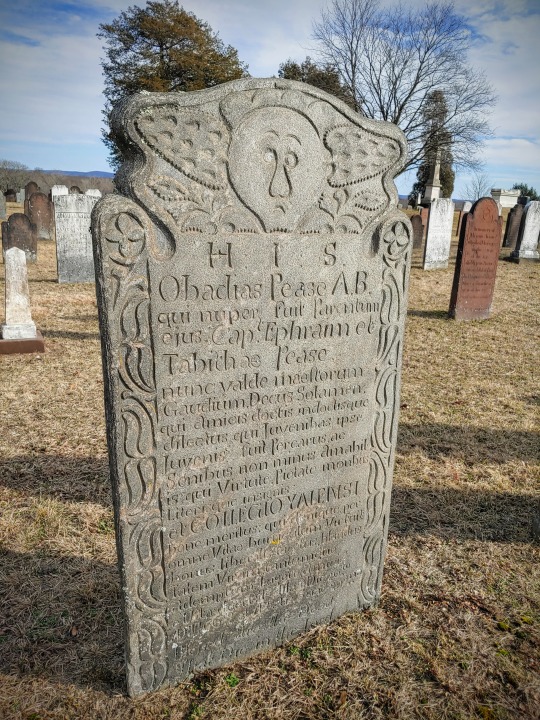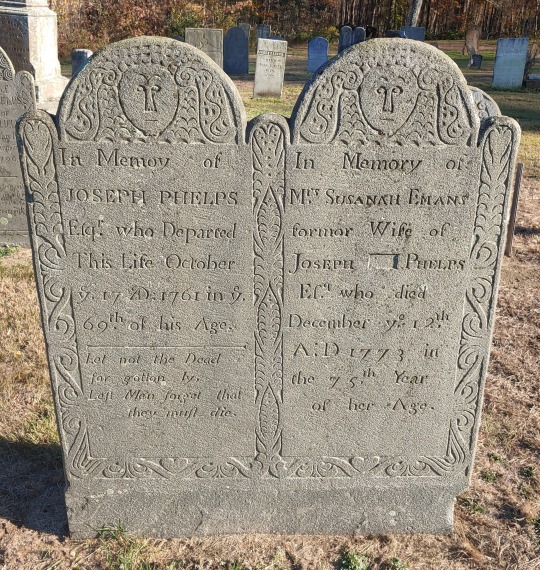#gershom bartlett
Explore tagged Tumblr posts
Text
Gershom Bartlett themed tramp stamp would go unfathomably hard.
6 notes
·
View notes
Photo

This elaborate grey schist maker in the Enfield Street Cemetery was carved by Gershom Bartlett of Bolton Connecticut. Bartlett’s father was a carver, and so were several other relatives, though they carved in a style imitating the plain sharp stones of George Griswold. Gershom first began carving in South Windsor on brownstone in the late 1740’s. He would soon move back to his hometown of Bolton and purchase the land of which he would start the Bolton Notch granite schist quarry, which he would source material for markers from. Bartlett originally used some design elements from Joseph Johnson of Windsor, though he quickly created his own unique design, revolving around a bulbous face that often resembled a lightbulb, lobed wings, clover rosettes, and a nose and eye design that resembled a hook and eye. On more elaborate stones like this one, he would incorporate large wings that almost resemble strawberries, and more elaborate border patterns. He was the most popular carver in Eastern Connecticut during his career, with work spread in large numbers in such towns as Colchester, Wethersfield, Woodstock, Enfield, Scotland, Hartford, Hebron, Farmington, Windham, and his hometown of Bolton. Numbers of his markers spread as far south as Old Lyme and New London, as far east as Brooklyn and Sterling, and as far north as Charlton Mass and many other towns in between. His quarry produced a durable, attractive grey schist and many other cavers would often purchase raw material from the quarry, including Josiah Manning, Jonathan Loomis, the Buckland Brothers, and Zerrubabel Collins among others. In 1774, rising land prices put a hold on Bartletts speculations on buying property and he would move with his family to Pompanoosuc Vermont where he would continue carving stones now from slate and he would become the most popular carver of the region again. He carved until his death in 1798, over 1200 of his stones left behind mixed in New Englands’ graveyards. This marker is carved entirely in latin, the only example of Bartletts work in that language, dates to 1765 and marks the grave of a Harvard Graduate, who died in the prime of his life.
#tombstonestombstoneconnecticut cemeteriesgravesgraveyardtombstone artgravestone artcemeterytaphophilefunerary artgrave markergravestoneold g#tombstones#tombstone#connecticut cemeteries#graves#graveyard#tombstone art#funerary art#gravestone art#grave marker#cemeteries#Colonial Cemeteries#Cemetery#Colonial funerary art#gershom bartlett
3 notes
·
View notes
Photo

Double Grave Marker carved by Peter Buckland of Manchester dated 1773.
Here we have a double stone of Bolton Schist for Joseph Phelps and his wife Susanah Emans dated 1773 carved by Peter Buckland of Manchester Connecticut. Peter Buckland carved on a number of different stones including grey granite schist from the Bartlett quarry in Bolton as seen here, as well as brownstone from different quarries on the Connecticut river. Both Peter and his brother William Buckland apprenticed early on under prolific gravestone carver Gershom Bartlett, and would remain influenced by his work, as you can see from the same vine borders used here and elements in the face. This stone also shows flared curled lobed wings, somewhat like that used by Windsor carver Joseph Johnson. Bucklands style would influence other stonecutters especially among the Ritter family of East Hartford. Peter Bucklands work was popular in such towns as East Hartford, Glastonbury, Wethersfield, Tolland, South Windsor and of course his hometown of Manchester. This marker is located in the Old Hebron Cemetery on Wall Street in Hebron Connecticut.
#tombstones Peter Buckland Colonial funerary art burying ground burying ground Colonial funerary art colonial cemetery cemeteriesofnewengland#tombstones#Peter Buckland#Colonial funerary art burying ground#burying ground#Colonial funerary art#colonial cemetery#cemeteriesofnewengland#colonial gravestone#gravestone art#tombstone#funerary art#colonial cemeteries#gravestones#momento mori#colonial gravestones#gravestone carver#grave carver
13 notes
·
View notes
Photo

Brownstone grave marker for Anne May dated 1775 carved by Peter Buckland of Manchester. While most brownstone in Connecticut was quarried from the Chatham/Portland Quarries, Peter and his brother William Buckland owned a Brownstone Quarry in Manchester (Buckland Quarry) which was a redder and more durable stone than the Portland brownstone. Buckland Quarried Brownstone was used for building and some carvers including Thatcher Lathrop and Daniel Ritter used it for gravestones. The Bucklands also often used Bolton Schist for stones as well. One can see some influence in much of the Buckland Brothers work from Gershom Bartlett, look at the nose and eyes on this stone for example,. Both brothers apprenticed with Bartlett early in their career. This stone along with many other Buckland stones of both Brownstone and Schist is located in the Weathersfield Village Cemetery, Weathersfield CT.
#cemetery#taphophile#old graveyard#old cemetery#cemeteries#new england cemetery#connecticut#burying ground#new england#colonial history#american history#tombstones#tombstone#tombstone art#grave marker#funerary art#graves#graveyard#gravestone#gravestone art
25 notes
·
View notes
Photo

This cheerful faced stone for Sarah Stiles dated 1776, was carved by Johnathan Loomis of Coventry Connecticut. Johnathan Loomis was a first generation grave carver who began carving stones out of Bolton Schist in the early 1750′s. He had a son (John Loomis) who he taught the trade to and continued the family business and eventually taught his own son Amasa Loomis who carved until his death in 1840. Unlike most carvers who has one or two primary influences, his work often incorporates designs inspired many other carvers including Benjamin Collins, Obadiah Wheeler, Gershom Bartlett, John Huntington, as well as many of his own original designs. Stones by Loomis have a variety of borders such as circles shown here as well as different vines, diagonal lines, abstract pillars, rosettes and even fruiting berry stalks. His wings were often lobed styles similar to those used by Bartlett though he had other original kinds like the ones used on this stone. He also used a variety of stone shapes and arches. He carved until his death in 1785, and was buried near his son in South Street Cemetery Coventry, both oddly under stones carved by Thatcher Lathrop. His work is concentrated in parts of Tolland, Windham and New London Counties in such towns like Coventry, Andover, Mansfield, Colchester and Scotland among others. This stone along with other works by Loomis is in Grant Hill Cemetery in Coventry CT.
#gravestone art#graveyard#taphophile#gravestone#grave marker#funerary art#cemetery#old graveyard#old cemetery#cemeteries#new england cemetery#connecticut#burying ground#new england#colonial history#american history#tombstones#tombstone art#connecticut cemeteries#graves#tombstone
1 note
·
View note